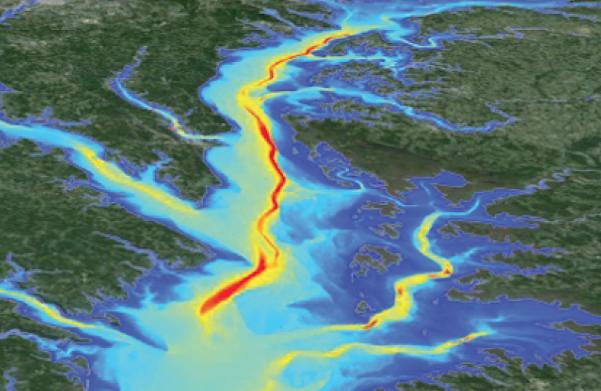The Chesapeake Bay’s infamous “dead zone” will be larger than average this summer, scientists suggest in a new forecast that breaks with a wave of encouraging signs about the estuary’s health.
If their prediction is correct, 2018 will be the fourth year in a row that the size of the Bay’s oxygen-starved area has increased. The forecasted expansion can be chalked up to nutrients flushed into the Bay during the spring’s heavy rains, according to researchers at the University of Maryland Center for Environmental Science and the University of Michigan.
“The size is going to go up and down every year depending on the weather,” said Don Scavia, a University of Michigan aquatic ecologist and one of the report’s authors.
A “dead zone” is a popular term for waters that have very little oxygen (hypoxic) or none at all (anoxic). Fish tend to flee, and any marine life that can’t escape — usually shellfish — could suffocate.
New evidence seems to arrive almost daily suggesting that humans are turning the tide against the Chesapeake Bay’s many woes. Bay grasses are flourishing. Waters are less murky. Despite a harsh winter, the blue crab population’s rebound appears undaunted. Officials and scientists at a press conference on June 15 celebrated the Bay’s ability to maintain moderately healthy conditions in 2017 for the third year in a row.
But the dead zone has remained persistently large over the years, though it has been disappearing slightly earlier at the end of the summer.
According to the U.S. Geological Survey, higher than average spring rains brought more than 85 million pounds of nitrogen into the Bay from the Susquehanna River, the primary source of nutrient pollution in the main portion of the Chesapeake. The Potomac River delivered another 30 million pounds to the Bay.
As a result, the dead zone is expected to be an average of 1.9 cubic miles this summer, a 5 percent increase over 2017, according to the forecast. That area of “hypoxic,” or low oxygen, water represents about 15 percent of the Bay’s total volume. Those numbers haven’t changed much over the years, said UMCES researcher Jeremy Testa, a co-author of the report.
Dead zone conditions already appeared to be forming in May, according to water quality-tracking by the Maryland Department of Natural Resources. The DNR Eyes on the Bay website showed that dissolved oxygen levels measured in early June had dipped into the danger zone for fish and shellfish from the Baltimore Harbor south to (and extending into) the Patuxent River. Along the Eastern Shore, the north-south boundaries are rougly the same — from Tolchester Beach in Kent County south to Dorchester County, across from the Patuxent.
Dead zones form are caused by excessive nutrients in the water, which cause algae to bloom. Ultimately, the algae die and sink to the bottom, where they are consumed by bacteria in a process that uses up the oxygen in the water. Low-oxygen waters are found throughout the world, from the Gulf of Mexico to the Baltic Sea.
The Chesapeake’s dead zone has ballooned since recordkeeping began in the 1950s as growing cities and farm fields shunted more nitrogen into the Bay, researchers say. One of the main goals of the federal-state Chesapeake Bay restoration program is to reduce nitrogen and phosphorus loads — and shrink the dead zone.
The typical summer dead zone has measured about 1.7 cubic miles of water since 1985, according to the Chesapeake Bay Program. The largest recorded was 2.7 cubic miles in 2011.
While hypoxic water remains stubbornly abundant, anoxic conditions — the very worst areas where there is virtually no oxygen — are gradually improving, Testa said. This year’s anoxic portion of the Bay is expected to be 0.43 cubic miles.
Testa attributes the improved anoxic conditions to gradual reductions in the Susquehanna’s nitrogen concentration that began in the 1980s. Scavia said this year’s forecasted expansion isn’t too concerning because rain appears to be the main culprit.
“It’s the long-term trend that really matters,” he said.
by Jeremy Cox
Bay Journal staff writer Jeremy Cox teaches communications at Maryland’s Salisbury University. He has written for daily newspapers since 2002, most recently as an environment reporter for the Daily Times in Salisbury, where he is based.



Write a Letter to the Editor on this Article
We encourage readers to offer their point of view on this article by submitting the following form. Editing is sometimes necessary and is done at the discretion of the editorial staff.